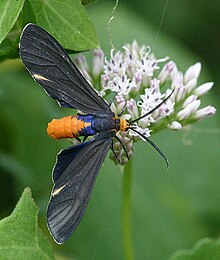
Hemaris thysbe, the hummingbird clearwing, is a moth of the family Sphingidae (hawkmoths). Coloration varies between individuals, but typically the moth is olive green and burgundy on its back, and white or yellow and burgundy on the underside. Its wings are transparent with a reddish-brown border. It has light-colored legs, which combined with the lack of striping on the underside is diagnostic. Beating its wings rapidly, H. thysbe hovers to collect nectar from a variety of flowers. The combination of its appearance and its behavior commonly leads to it being confused with a hummingbird or bumblebee.

Citheronia sepulcralis, the pine-devil moth, is a Nearctic member of the family Saturniidae and of the subfamily Ceratocampinae. The species are blackish brown. The species was first described by Augustus Radcliffe Grote and Coleman Townsend Robinson in 1865.

Dahana is a genus of moths in the family Erebidae erected by Augustus Radcliffe Grote in 1875.
Didasys is a monotypic tiger moth genus in the family Erebidae. The genus contains the single species Didasys belae, the double-tufted wasp moth, which is found in the US states of Florida and Alabama. Both the genus and species were first described by Augustus Radcliffe Grote in 1875.
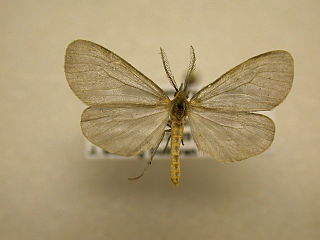
Pagara is a monotypic moth genus in the family Erebidae. Its only species, Pagara simplex, the mouse-colored lichen moth, is found in North America, where it has been recorded from Alabama, Arkansas, Florida, Georgia, Illinois, Indiana, Iowa, Kansas, Kentucky, Maryland, Mississippi, New Hampshire, North Carolina, Ohio, Oklahoma, South Carolina and Tennessee. Both the genus and species were described by Francis Walker in 1856.

Apamea vultuosa, the airy apamea, is a moth of the family Noctuidae. It is found from coast to coast in southern Canada and the northern United States, south in the west to Oregon and Colorado, and south in the east to Florida.
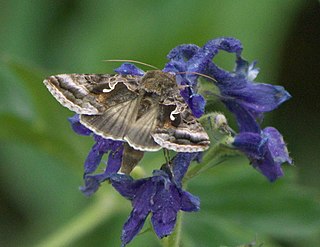
Autographa pseudogamma, the delicate silver Y, is a moth of the family Noctuidae. The species was first described by Augustus Radcliffe Grote in 1875. It is found in North America from Newfoundland to coastal northern Alaska, south in the east to New England and in the western mountains to New Mexico, Arizona and California. It is also found in the Cypress Hills and the Black Hills of South Dakota.

Catocala verrilliana, or Verrill's underwing, is a moth of the family Erebidae. The species was first described by Augustus Radcliffe Grote in 1875. It is found in the US from Washington and Oregon to Colorado and south to California, Arizona and Texas, and Cimarron County in western Oklahoma.

Euparthenos is a monotypic moth genus in the family Erebidae erected by Augustus Radcliffe Grote in 1876. Its only species, Euparthenos nubilis, the locust underwing, was first described by Jacob Hübner in 1823. The adults resemble some of the underwing moths of genus Catocala, which are fairly close relatives, in color, pattern, and the habit of resting on tree trunks. But E. nubilis can usually be immediately recognized by the four concentric black bands per hindwing, as opposed to one or two in Catocala. Color morphs of E. nubilis with altered pattern are known, however, and these may be hard to recognize without detailed examination.
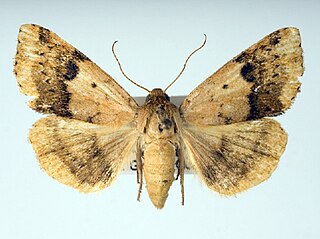
Heliocheilus lupatus, the purple topper, lupatus straw moth or spotted straw moth, is a moth in the family Noctuidae. The species was first described by Augustus Radcliffe Grote in 1875. It is found in the United States from Kentucky and central Connecticut south to Florida and Texas.
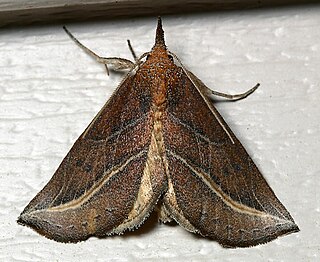
Phyprosopus callitrichoides, the curve-lined owlet, is a moth of the family Erebidae. The species was first described by Augustus Radcliffe Grote in 1872. It is found in the US from New Hampshire to Florida, west to Montana and Texas.
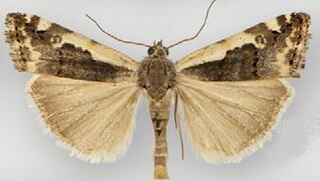
Tarache augustipennis, the narrow-winged midget, is a moth of the family Noctuidae. The species was first described by Augustus Radcliffe Grote in 1875. It is found in North America from Manitoba to south-western British Columbia, south to Arizona and east to Texas.

Arta statalis, the posturing arta moth, is a species of snout moth in the genus Arta. It was described by Augustus Radcliffe Grote in 1875 and is the type species of its genus. It is found in North America including Delaware, Florida, Georgia, Illinois, Iowa, Massachusetts, New Jersey, New York, North Carolina, Oklahoma, Pennsylvania, South Carolina, Tennessee and Virginia.
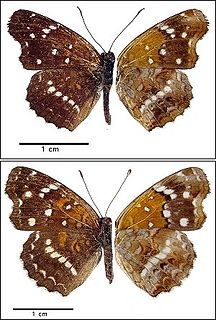
Anthanassa texana, the Texan crescentspot, is a species of butterfly in the family Nymphalidae. It is found from Guatemala north through Mexico to southern California, east across the southern United States to northern Florida, Georgia and South Carolina. Strays may be found up to Arkansas, Missouri, Illinois, South Dakota, and central Nevada. The habitat consists of deserts, dry gulches, open areas, streamsides, road edges, and city parks.

Cisthene packardii, or Packard's lichen moth, is a moth of the family Erebidae. It was described by Augustus Radcliffe Grote in 1863. It is found in the US from the states of New York to Florida and from Missouri to Texas. The habitat consists of barrens and dry oak woodlands in the northern part of the range and a variety of woodlands and scrubs in the south.
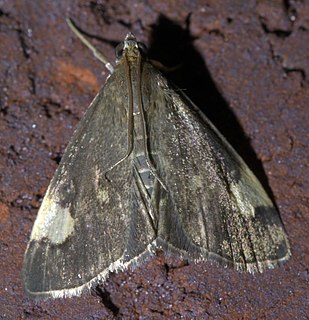
Evergestis unimacula, the large-spotted evergestis moth, is a moth in the family Crambidae. It was described by Augustus Radcliffe Grote and Coleman Townsend Robinson in 1867. It is found in North America, where it has been recorded from Georgia, Illinois, Indiana, Iowa, Maryland, Michigan, North Carolina, Ohio, Oklahoma, Ontario, Pennsylvania, Quebec, Tennessee and West Virginia. Outliers have been recorded from Florida.
Colomychus talis, the distinguished colymychus moth, is a moth in the family Crambidae. It was described by Augustus Radcliffe Grote in 1878. It is found in Mexico and the south-eastern United States, where it has been recorded from Alabama, Arkansas, Florida, Georgia, Maryland, North Carolina, Oklahoma, South Carolina and Virginia.

Hyperstrotia secta, the black-patched graylet moth, is a moth of the family Erebidae. The species was first described by Augustus Radcliffe Grote in 1879. It is found in North America, where it has been recorded from Alabama, Arkansas, Florida, Georgia, Illinois, Indiana, Kentucky, Louisiana, Maryland, Massachusetts, Mississippi, New Hampshire, New Jersey, New York, North Carolina, Ohio, Oklahoma, South Carolina, Tennessee, Virginia and West Virginia.

Metalectra tantillus, the black fungus moth, is a moth of the family Erebidae. The species was first described by Augustus Radcliffe Grote in 1874. It has been recorded from the US states of Alabama, Florida, Georgia, Illinois, Iowa, Kentucky, Maryland, Mississippi, New Jersey, North Carolina, Ohio, Oklahoma, Pennsylvania, South Carolina, Tennessee, Texas, West Virginia and Wisconsin.
Epiglaea apiata, the pointed sallow moth or cranberry blossom worm, is a moth of the family Noctuidae. It is found in North America, where it has been recorded from Florida, Georgia, Indiana, Louisiana, Maine, Maryland, Michigan, Minnesota, New Brunswick, North Carolina, Ohio, Quebec, South Carolina and Wisconsin.
